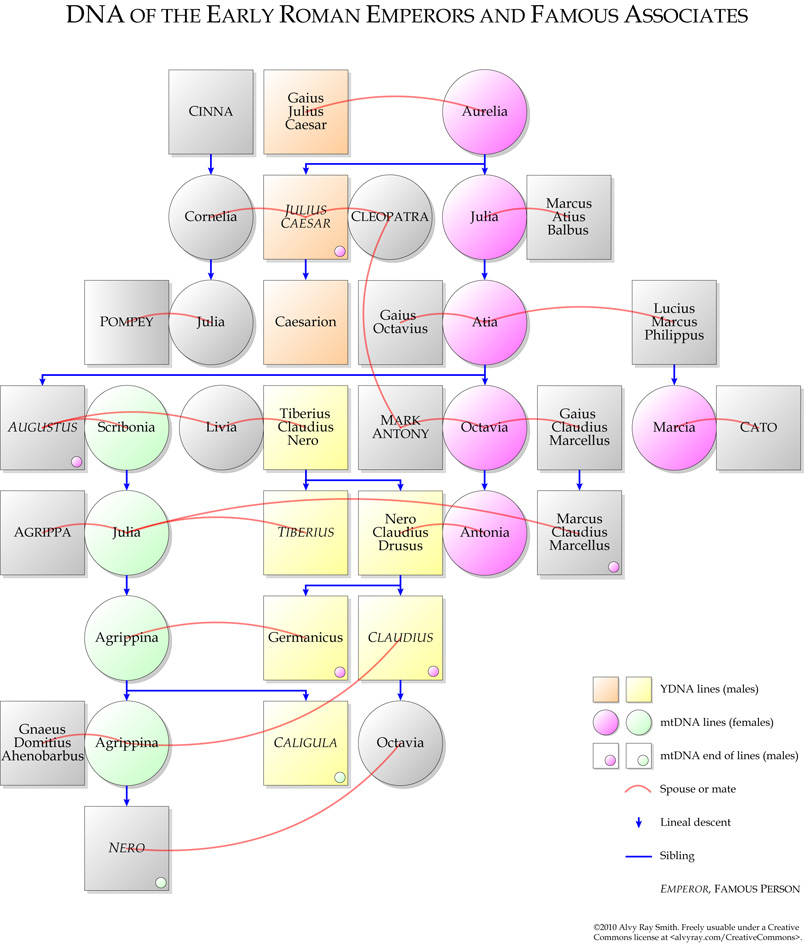


DNA of the Early Roman Emperors and Famous Associates by
Alvy Ray Smith is licensed under a
Creative Commons Attribution-NoDerivs 3.0 Unported License.
Based on a work at
alvyray.com/CreativeCommons, which is the .pdf
version of this image.
Required attribution is: "By Alvy Ray Smith, 2010." The work is to be used in its entirety only.
My caption (from the Edge website for the Map Marathon):
DNA of the Early Roman Emperors and Famous Associates: Squares are males. Disks are females. Blue arrows show direction of descent. Horizontal blue bars bind siblings. Red curves join "spouses" – that is, procreative couples. In cases of multiple spouses, the child goes with the most tightly bound spouse. Yellow squares represent one strain of Y-chromosome DNA (YDNA) passed down via males only; orange another. Magenta disks represent one strain of mitochondrial DNA (mtDNA) passed down via females only; green another. Small disks within squares are males carrying the designated mtDNA, who could not, being male, pass it on. The surprise is the predominance of the mtDNA lines over the YDNA – that is, of the feminine connections over the masculine..
Here is a more exhaustive explanation:
The longest unbroken chain of DNA is mitochondrial DNA which lasted for six generations, so far as this chart is concerned. Aurelia, mother of Julius Caesar, passed her mtDNA (designated by magenta disks) down five generations of women to Antonia, Mark Antony's daughter, who passed it on to Claudius and his brother Germanicus. Males inherit mtDNA from their mothers but cannot pass it on, so I have shown its presence in the last two men as a small magenta disk at the lower right of the boxes representing them. The rule is this: Only women can pass mtDNA down, but all children of a woman, male or female, have her mtDNA. It dead-ends at the males.
Three early emperors had Aurelia's mtDNA: Julius Caesar, Augustus, and Claudius. (For ease of presentation I call Julius Caesar an emperor too although technically it was Augustus who was the first emperor.) The emperors and famous others are shown in bold italics.
Three early emperors had the same Y chromosome: Tiberius, Claudius, and Caligula.
The second longest unbroken chain of DNA is another mtDNA chain, this one of five generations, so far as this chart is concerned. Scribonia, wife of Augustus, carried this particular mtDNA, shown by the green disks.
Two early emperors had Scribonia's mtDNA: Caligula and Nero.
The short orange YDNA chain includes Julius Caesar and his son by Cleopatra.
Claudius is included in two of these chains, the yellow YDNA chain and the magenta mtDNA chain. Caligula is included in both the yellow YDNA chain that the green mtDNA chain. Julius Caesar is in both the orange YDNA chain and the magenta mtDNA chain.
For example, Augustus married (1) Scribonia and (2) Livia. His daughter Julia is Scribonia's child not Livia's, because Scribonia's disk is closer to Augustus's square than is Livia's disk.
Another example, Julia married (1) Marcellus, (2) Agrippa, and (3) Tiberius, but her daughter Agrippina is Agrippa's (the name also tells).
And Octavia married (1) Marcellus and had Marcellus (again the name tells), and (2) Mark Antony and had Antonia (the name again).
I obtained the data for this chart from Anthony Everitt, Augustus: The Life of Rome's First Emperor (New York: Random House, 2006) and from Wikipedia. I have omitted much information but have added the DNA information which makes this chart unique. The gray squares and disks have DNA that wasn't interesting for this exercise in my opinion.